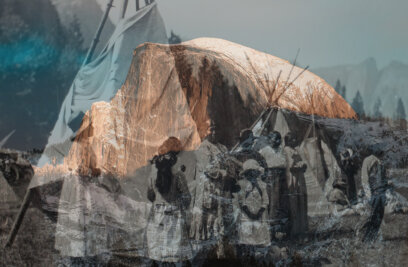America’s Conflicted Landscapes
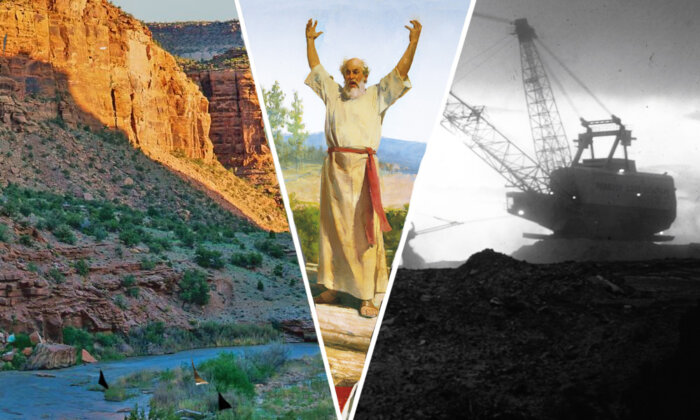
Americans invented the idea of national parks. They sing of amber waves of grain and sublime purple mountain majesties. They’ve made the Grand Canyon, Yosemite, and Yellowstone shrines of national identity and idealize nature in speeches, literature, painting, photography, and architecture.
And yet American lands today are torn by conflicts over science, religion, identity, and politics, with contradictory conceptions of nature at the heart of a broken national consensus.
To Native Americans, nature and culture are inseparable, and the identity and the history of a tribe is thoroughly interwoven with specific places, such as Rainbow Bridge or the San Francisco Peaks. In contrast, many White Americans embrace wilderness, defined as nature that is free of human presence, with no roads, telephone lines, or electricity. The wilderness is, to them, eternal and pre-human, an idea at odds with both Native Americans and the utilitarian concept of nature that is dominant in American society, one which treats nature as a stockpile of resources awaiting exploitation and development. In fact, there is a long American tradition that views transformations such as dams, roads, bridges, and urban growth as a harmonious completion of the original landscape. As if the river was always intended for irrigation and a mountain pass was patiently waiting for a railway line. Creationists, meanwhile, contend that the biblical flood described in the Book of Genesis carved American landscapes fewer than 10,000 years ago and that earth’s natural resources are still being created — a view completely at odds with the science of geology.
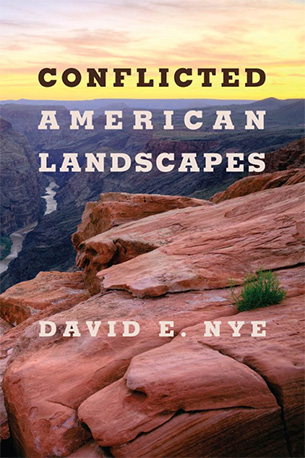
These conceptions of nature entail radically different understandings of history. Does nature represent eternity, ancestors, science, the present, the future, or a young earth? Is it to be revered, conserved, exploited, or sacrificed? A nation that identifies itself with nature begins to fall apart when it can no longer agree on what nature is.
Since World War II the relationships between these conceptions have shifted dramatically; unifying them has become even more difficult in recent decades. Today, many Americans worry about global warming, species extinction, and pollution. They question highway projects, new pipelines, strip mining, reliance on fossil fuels, and the location of waste disposal sites. At the same time, creationists have become more numerous, particularly in the Southwest. Their biblical sense of history explains the United States in terms of Manifest Destiny and American exceptionalism.
When President Ronald Reagan ran for reelection in 1984, his campaign slogan declared “It’s Morning in America.” It suggested that the United States was just beginning, and that most of its second creation lay ahead. This message appealed to his creationist supporters, as did Reagan’s declaration that both evolution and creation theory ought to be taught in public schools. America’s second creation acquired greater resonance if human history began only a few thousand years ago. From the 1930s to the 1970s, the Bureau of Reclamation’s projects, such as Glen Canyon Dam, had been justified by the utilitarian benefits of hydropower, flood prevention, irrigation, and recreational boating. But some creationists saw these projects as the unfolding of American destiny.
Even as creationism became more common, support for wilderness also grew. The wilderness movement relied on a scientific approach to landscape that called attention to all plants, birds, insects, and animals, rather than presenting human beings as a non-evolutionary special creation of God. Scientific investigation showed the complexity of landscape, documented the rising rate of species extinction, and gathered evidence of global warming. The evidence undermined the possibility of wilderness itself. As the German sociologist Ulrich Beck concluded, “Anyone who continues to speak of nature as non-society is speaking in terms from a different century, which no longer capture our reality. In nature, we are concerned today with a highly synthetic product everywhere, an artificial ‘nature.’ Not a hair or a crumb of it is still ‘natural,’ if ‘natural’ means nature being left to itself.” Historians, literary critics, and anthropologists reached similar conclusions. If wilderness lacked credibility, however, to environmentalists, a designated wilderness was clearly preferable to subjecting any site to uranium mining, oil extraction, or nuclear tests.
The clash of creationism with science had philosophical implications and political consequences. Consider the philosophical implications first. Diametrically opposed views could be attached to the natural sublime, depending upon whether one believed in creationism or evolutionary science. Since Jefferson’s era, some Americans have seen natural bridges and other natural wonders as proof of the existence of God. A scientific understanding of the same spectacular landscapes did not detract from their sublimity but saw in them the proof of geological theory, the immensity of time, and the insignificance of human history. Creationists and evolutionists agreed that these sites were sublime, but their understandings of them were incompatible.
Politically, tensions between different conceptions of the land sharpened conflicts over dams, irrigation, tourism, mining, atomic testing, waste storage, and wilderness. For generations, Americans alternated among several land ethics, depending upon audience and occasion. Every president celebrated the utilitarian development of natural resources. Every president also praised the creation of public parks and other pastoral landscapes. And after 1964 every president designated wilderness areas. Lyndon Johnson and his successor, Richard Nixon, each set aside millions of acres to remain unspoiled in perpetuity, and the presidents after them added more. Politicians had an appropriate rhetoric for each situation.
Creationists and evolutionists agreed that these sites were sublime, but their understandings of them were incompatible.
Visiting a factory or mine called for the utilitarian narrative of economic growth and a brighter tomorrow. In 1977, Jimmy Carter visited West Virginia to promote coal. “One inevitable major shift in the years ahead is away from oil and natural gas and toward coal,” he declared. “We want to be sure that when this shift is made that a continuing substantial major portion of the coal to be used comes from the Appalachian region.” In contrast, when Carter established the William O. Douglas Arctic Wildlife Range in Alaska’s Brooks Mountains as a wilderness area, it was preserved so that future generations could experience a remnant of virgin land as a foil to civilization. Carter quoted the late Supreme Court Justice Douglas: “The Arctic has a call that is compelling. The distant mountains make one want to go on and on over the next ridge and over the one beyond. The call is that of a wilderness known only to a few. . . . This last American wilderness must remain sacrosanct.”
During the Cold War, Americans maintained a political consensus that simultaneously they could have wilderness, pastoral retreats, and industrial development, including atomic power plants and nuclear weapons. This consensus united both Republicans and Democrats. By the 1990s, however, this balancing act between development and preservation had become precarious. Some mining and oil interests had always opposed setting aside national monuments and wilderness areas. Likewise, many residents of western states, where national parks, monuments, and wilderness areas predominate, thought the second creation story should apply to Utah and Colorado as much as it did to New Jersey and Georgia. At the same time, creationism spread, and a 2008 Gallup poll found that 60 percent of all Republicans thought “humans were created in their present form by God 10,000 years ago,” a belief shared by 40 percent of Independents and 38 percent of Democrats.
The gap between the two parties on environmental issues widened during the 2000 presidential election. The former oil executive George W. Bush championed utilitarian resource extraction and second creation. He pushed to boost federal funding and support of research and development in coal technology and supported drilling for oil in the Arctic National Wildlife Area. (In 2018, President Trump had similar policies.) Bush did not consider global warning a serious problem, and placed a higher priority on stimulating the economy. Both he and Vice President Dick Cheney argued that mining companies and petrochemical industries were entitled to national resources, a view shared by most corporations and chambers of commerce. When campaigning, Bush called CO2 a pollutant, but after taking office, he redefined it as merely an emission.
Bush’s opponent, Al Gore, held opposed positions. In “Earth in the Balance,” he argued that resources were limited and that the environment was in peril. He wanted to mandate greater automobile fuel efficiency and to impose a carbon tax on industry in order to mitigate global warming. Gore gave a voice to environmentalists, indigenous peoples, workers, and injured biotic communities, including Mormon towns downwind of atomic testing, Navajo and Hopi reservations, and the ecologies of damaged sites such as Glen Canyon. He wanted to clean up and restore polluted areas. His politics extended Gifford Pinchot’s work on forest restoration, New Deal conservation programs, and the Environmental Protection Agency’s restitution of Superfund sites such as the River Rouge and abandoned uranium mines. As late as 2008, a few Republicans also saw global warming as a problem, including John McCain who led the party in that year’s election campaign. Afterward, the two parties completed the polarization that had begun in the 1990s.
Two generations ago mainstream Republican and Democratic leaders embraced both national parks and interstate highways, both wilderness and development.
In 2002, Mike Pence gave a speech in Congress that embraced Intelligent Design, the idea that evolution took more than 10,000 years but was guided by “the Lord.” In subsequent elections, many Republican candidates for president, including Michele Bachmann, Rick Perry, Mitt Romney, and Rick Santorum, declared that they too believed in Intelligent Design. When the well-qualified Republican candidate John Huntsman said he believed in evolution, Santorum rebuked him: “If Governor Huntsman wants to believe that he is the descendant of a monkey, then he has the right to believe that — but I disagree with him on this and the many other liberal beliefs he shares with Democrats.”
Two generations ago mainstream Republican and Democratic leaders embraced both science and the Declaration of Independence, both national parks and interstate highways, both wilderness and development, both the natural and the technological sublime. But Democrats increasingly became the party of environmentalists, while Republicans increasingly adopted an uncompromising utilitarianism at odds with Teddy Roosevelt’s conservation policies. The national government was also internally divided. The Departments of Commerce and Agriculture maintained the utilitarian land ethic, while ecological concerns were more salient at the Environmental Protection Agency and at some (but not all) divisions of the Department of the Interior. The Department of Energy spent most of its funds on the nuclear industry, yet it also promoted wind and solar power. Moreover, every department of government was pressured to adjust its priorities when control of the White House changed.
The opposition between utilitarianism, infused with creationist zeal, and environmentalism, bolstered by scientific research, often dominates the headlines, but it does not fully express the variety of American conceptions of nature, which also include pastoralism, Native American religions, and fears of fatal environments like Love Canal, Picher, and other “anti-landscapes” of industrialization.
When a Diné (Navajo) child is born, the family buries the umbilical cord beside the home, underscoring the child’s link to that particular place. As Navajo poet and scholar Luci Tapahonso writes in her essay “Ode to the Land,” “this ensures that throughout life, she or he will always return home, that the child will always take care of his or her parents and that the child will not wander aimlessly as an adult.” This is a more intimate relationship with the land than mere real estate ownership. As the Navajo Roberta Blackgoat explained, “If there is a beautiful old tree, and you dig it up and move it, do you think it will continue to live? Even if you do everything you can to prepare new ground for it, do you think that old tree will live? No, it won’t live. And it is the same way with us. When they move us away, we will die.”
“If there is a beautiful old tree, and you dig it up and move it, do you think it will continue to live?”
Yet many Navajo have been forced to move because their homes became part of conflicted landscapes. In the 1960s, the Bureau of Reclamation had expected to build additional dams inside the Grand Canyon, which would provide the electrical power necessary to pump billions of gallons of Colorado River water to Phoenix and Tucson. When these dams were blocked by a coalition of environmentalists and Native Americans, the government successfully argued for a massive coal mine to serve one of the largest power stations in the United States. Coal mining proved deeply troubling to the Navajo. The coal-fired power plant at Page provided well-paid jobs and payments into the tribe’s coffers. But the tribe members, who had always enjoyed clean air and blue skies, confronted “a brown sky smelling of burning dirty clothes and old tires. The smoke,” which contained sulfur dioxide, lead, and mercury, rolled “up the hill, over the poisoned lake and the chemical-coated grass,” and billowed into the skies around the Grand Canyon. To the tribe, the worst desecration was “a giant coal mining dragline” that tore up their ancestors’ graves, as it heaved coal out of the earth.
Another Navajo activist declared to the Civil Rights Commission in 1974: “To the Navajo people it seems as if these Europeans hate everything in nature — the grass, the birds, the beasts, the water, the soil, and the air.” The utilitarian ideology, expressed in Supreme Court decisions and land-use policies, rejects Native American perspectives, and this rejection was often intertwined with the ideology of the technological sublime. As Rob Nixon observed in his book “Slow Violence and the Environmentalism of the Poor,” oil and mining corporations have “long sought to exploit the romance of the technological sublime — imagining the unimaginable, venturing into the unknown.”
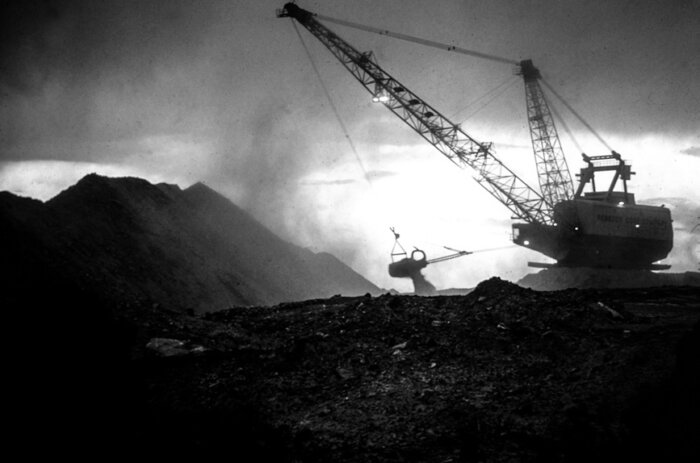
Highways have been bulldozed, rivers dammed, and mines carved out of the mesas. Sacred places such as the Black Hills of South Dakota are mined, and Rainbow Bridge is appropriated and developed as a tourist site. A telling exchange during a Senate hearing in 2002 revealed explicitly how the Department of the Interior repeatedly has ignored Native American requests to protect their sacred sites. The senator from Colorado, Ben Nighthorse Campbell, asked Christopher Kearney from the Department of the Interior, “Can you give the committee a couple of instances in which tribal complaints have stopped a big development, say a mine development?” Kearney admitted, “In my direct experience, nothing immediately comes to mind. Senator Campbell then noted, that Native Americans had “never been able to stop one [mine]. I mean, there might be some consultation, but the bottom line is it gets done.”
This exchange occurred during an investigation into why the Bush administration approved an application to mine gold on Quechan tribal lands near Yuma. The mine was to run day and night and to pump up from beneath the desert 1,250 acre feet of ground water per year. The tribe vehemently objected, and President Clinton’s Department of the Interior concluded the mine would destroy one of the most endangered Native American sacred sites. It also would pollute the adjacent Indian Pass Wilderness Area (created in 1994) and its three natural bridges, and it would be deleterious for endangered species. The Quechan and the other tribes, the Department of the Interior declared after five years of hearings and investigations, would not be able “to travel, both physically and spiritually, along the Trail of Dreams; to make ceremonial use of the prayer circles, rock alignments, and other cultural features in the project area; to gain protection from metaphysical dangers; and to continue to use the project area for vision quests and teaching tribal youths about their culture.” Many shrines had been built along this trail, and the area also included “an extensive assemblage of Native American scratched petroglyphs.”
The Bush administration ignored these conclusions, snubbed the Quechan tribe, and approved the lease. It appeared to be a lost cause, until California passed a law requiring mining corporations to fill in disused open pits, a requirement that made the gold mine uneconomical. The company sued, but lost, and the Quechan lands were saved.
As in this case, the battles are between Republicans and Democrats, state and federal governments, Native Americans and the BIA, and environmentalists and mining corporations. All of these actors again came into conflict after President Clinton declared Grand Staircase-Escalante a national monument in 1996. Clinton tried to assuage fears that this vivid geological monument would stifle the local economy. At its dedication, he argued, “Mining jobs are good jobs, and mining is important to our national economy and to our national security. But we can’t have mines everywhere, and we shouldn’t have mines that threaten our national treasures. That is why I am so pleased that PacifiCorp has followed the example set by Crown Butte New World Mine in Yellowstone. PacifiCorp has agreed to trade its lease to mine coal on these lands for better, more appropriate sites outside the monument area.” But this land exchange did not placate local interests.
The community felt that it had lost 900 jobs at the proposed mine, that 1.7 million acres had “been ‘locked up,’ and that the county’s economic future was ‘locked out.’” Sensitive to these local rumblings, the senator from Utah Orrin Hatch called Grand Staircase-Escalante National Monument “the mother of all land grabs.” Similar protests in Wyoming had greeted Franklin D. Roosevelt when he created the Grand Teton National Monument, which later became a national park. The local population eventually accepted this decision, because the increased tourism proved a permanent source of income, unlike mining that provided short-term jobs and ruined the landscape with roads, craters, tailings, and pollution.
A national monument is seldom a homogeneous territory where a single set of regulations determines land use.
The conflict over Grand Staircase-Escalante intensified after 1996, as uranium mining increased nearby. In 2012, the Department of the Interior barred for a period of 20 years any new uranium mines on one million acres of land near the Grand Canyon. Mining companies contested this decision, but in December 2017, the Ninth U.S. Circuit Court of Appeals upheld the ban, whose purpose, as two former superintendents of Grand Canyon National Park explained, was to “protect the Grand Canyon and the millions of people in the Colorado River Basin that depend on the river for drinking water, irrigation and other uses.” Further protection from mining came in 2016 when President Obama created Bears Ears National Monument. The president of the Utah Association of Counties complained that the “president misuses his power under the Antiquities Act,” arguing that one man should not be able to lock up a million acres or more without the consent of Congress. Yet Obama was responding to an intertribal coalition of the Hopi, Navajo, Ute, and Pueblo Nations, who had complained that “Congress has turned their back on sites sacred to tribal nations, leaving Bears Ears at risk to the continued threats of grave robbing and vandalism, while destructive uranium, oil, and gas and potash mining projects are being proposed.” Bears Ears is a classic example of a conflicted landscape.
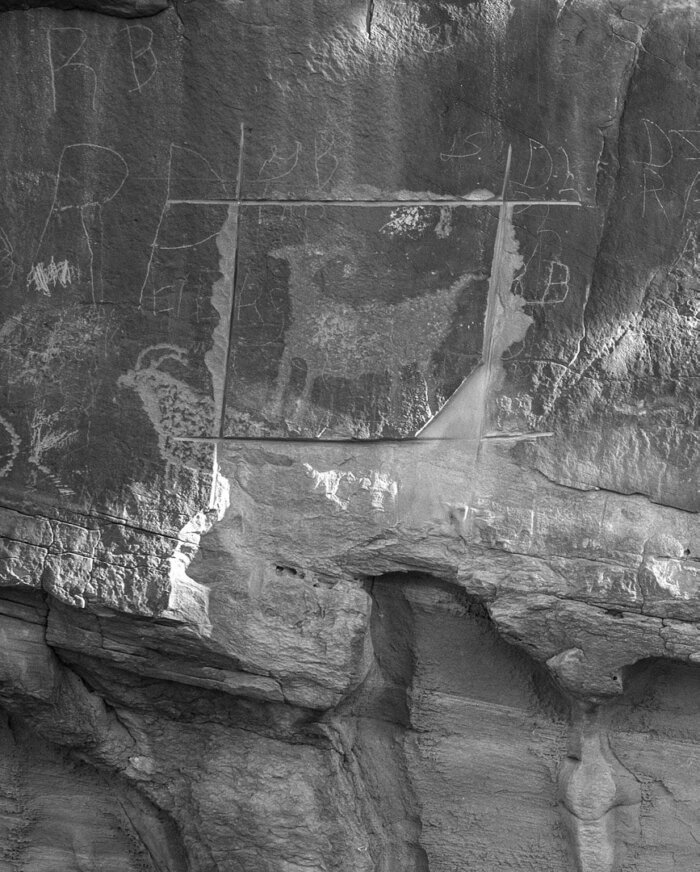
Together, Grand Staircase-Escalante and Bears Ears National Monuments not only saved a unique area from exploitation but also provided endangered species with an essential land bridge between the Grand Canyon and Zion National Parks. Each park can suffer local species extinctions; connecting them increases survival rates. Presidents Clinton and Obama were not only preserving biological diversity, protecting archeological sites, and preventing mining. These monuments could also help human beings rediscover their place in the natural world.
A national monument is seldom a homogeneous territory where a single set of regulations determines land use. On Bears Ears can be found thousands of Native American petroglyphs, artefacts, and ruins, many of which have suffered looting and vandalism. The petroglyphs carved in many parts of Utah stretch back 8,000 years, with a decisive shift in style after the adoption of agriculture. In recent decades, these art works have been under attack, often shot to pieces by visitors with guns. The Bureau of Land Management has at times done a worse job of preservation than private land trusts.
Bears Ears is a large site that is difficult to protect, with many stakeholders. About 15,000 acres are privately owned, and these resident ranchers and farmers need access to their property. The new national monument recognized their preexisting easements and rights of way, allowing them to move livestock and vehicles to and from their land. Similarly, when Grand Staircase-Escalante became a national monument, it contained 68 mining claims on 2,700 acres, 85 oil and gas leases encompassing 136,000 acres, and 18 coal leases on 52,800 acres. These leases remained valid if owners could prove that they had discovered a valuable deposit before September 18, 1996. In addition, the Bureau of Land Management recognized permits for grazing and for guides and outfitters operating inside the monument. The Utah Schools and Lands Exchange Act of 1998 conveyed 24,000 acres to Grand Staircase-Escalante, but it also acknowledged existing water rights, grazing permits, and mining leases. In short, while hiking through Grand Staircase-Escalante one might cross from public to private land, from wilderness to mining claims, from grazing areas to oil fields, often without obvious demarcation lines. In practice, a national monument may be a patchwork of farming, mining, drilling, grazing, ruins, and wilderness.
Given these complexities, some local residents saw new monuments as roadblocks to prosperity. Republicans not only sided with them, but began to push back against setting aside lands in perpetuity. In 2017, Secretary of the Interior Ryan Zinke recommended reducing or eliminating 27 national monuments. Immediately, President Trump rescinded 80 percent of Bears Ears and 45 percent of Grand Staircase-Escalante, which reopened one million acres to oil, gas, coal, and uranium extraction. Meanwhile, the EPA was still spending hundreds of millions of dollars removing radioactive waste from abandoned mines.
The conflicting plans for Grand Staircase Escalante and Bears Ears underline the tensions at work. One side calls for conservation of resources, preservation of wilderness, protection of archeological sites, and conversion to wind and solar energy. The other side calls for development of resources, mining on public lands, minimal protection of archeological sites, and continued reliance on fossil fuels. In such debates, Americans can no longer plausibly shift among their three traditional conceptions of nature, the wild, the pastoral, and the utilitarian. There is no shared vision. A country that for centuries identified itself with nature is divided against itself. The partially filled Glen Canyon reservoir, covering tons of radioactive waste, suggests where such intransigence can lead.
There is nothing inevitable in this scientific story. Human beings can destroy each other or not; they can improve or degrade their environment; they can limit their numbers or increase until the earth cannot support them. In the scientific view, no divine intelligence shapes history, and human intelligence only struggles to do so.
There is no shared vision. A country that for centuries identified itself with nature is divided against itself.
These quite different ideas find expression when people visit an impressive site like the Grand Canyon. To the Native Americans who live there, this landscape is imbued with their origin and identity. Creationists view the same site as a product of the biblical flood. Mining corporations have regarded the canyon as a potential source of wealth, and hydroelectric engineers have sought to build dams on the Colorado River. A tourist interprets the canyon in terms of the natural sublime, which requires little knowledge of the place and treats landscape as an abstraction. The tourist seldom knows its history or ecology and appears superficial to those intimately acquainted with the place. In contrast, a biologist who gazes at distant tamarisk thickets growing along the Colorado River knows that it is an invasive species, that the river before being dammed was reddish brown, not blue, and that the park management has eradicated wolves and other predators. The powerful emotions felt at Grand Canyon are framed so variously that they no longer unify Americans.
Nor can the technological sublime play a unifying role. Americans once shifted back and forth, with little sense of contradiction, between the technological and the natural sublimes. After the atomic bomb, the Anthropocene, and global warming, however, such easy alternation has been replaced by polarized intransigence. The nation’s history and politics cannot plausibly be based on second creation stories, nor can they be based on the mythology of virgin land and wilderness. Many are caught between visions of progress through resource exploitation and visions of redemption through immersion in wild nature. Both are hallucinations. Instead, Americans need to recognize the complexity of living within nature. The feeling of the sublime will not disappear, but it requires better interpretive frameworks. New structures of feeling and new narratives are urgently needed because the American ideologies of nature have led to political conflict, policy gridlock, and landscape destruction.
Inconsistent concepts of nature have greater consequences today than they did two generations ago. Few were concerned with climate change in 1964, when the eminent cultural geographer J. B. Jackson observed that “the human landscape is changing by a series of violent and unpredictable mutations, and no one is foolhardy enough to foresee what it will look like a generation hence.” The uncertainty is greater today, given the pace of technological innovation, population growth, pollution, species extinction, climate change, the melting of the polar ice caps and, exacerbating all of these problems, the fixation on economic growth as the measure of progress. The conflict between American conceptions of nature has intensified since 1964, even as the landscape itself has changed in disturbing and unpredictable ways. It is not morning in America, it is the Anthropocene.
David E. Nye is Professor of American History at the University of Southern Denmark. He is the author of several books, including “American Illuminations,” “When the Lights Went Out,” and “Conflicted American Landscapes,” from which this article is adapted.
